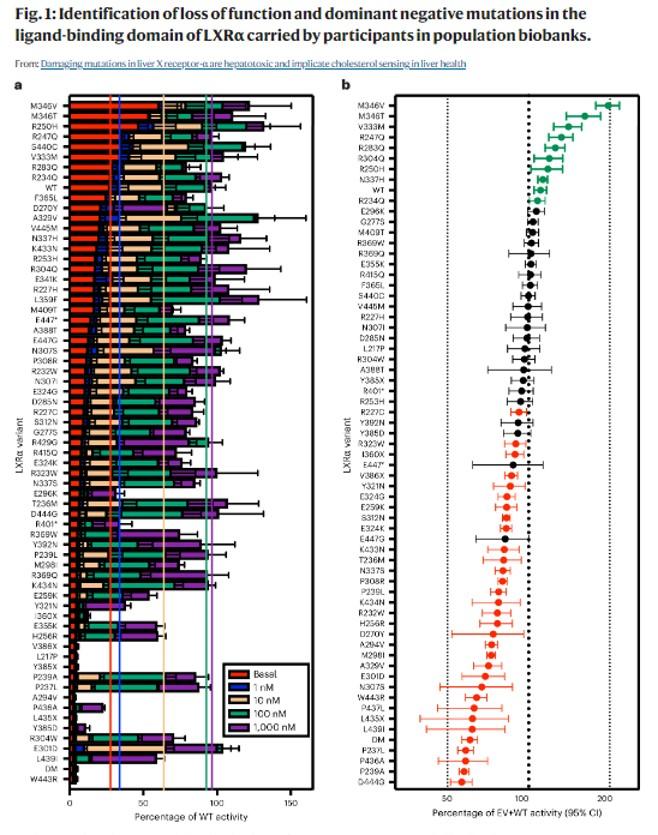
Submitted by aml95 on Wed, 25/09/2024 - 14:57
A study led by Sam Lockhart, Milan Muso, Steve O’Rahilly and others at the IMS-MRL, working with collaborators at the Universities of California, Newcastle and Leicester, has discovered that having some fat (specifically, a type of fat known as triglyceride) in liver cells may help the liver from being seriously damaged by cholesterol. This is important because drugs are in development to reduce liver fat and treat liver disease by blocking the action of a protein in the liver called Liver X Receptor alpha (LXRa) that controls levels of both cholesterol and triglycerides in the liver. The findings, published in Nature Metabolism suggest that this treatment approach, which would lower the fat but increase the cholesterol in liver cells, may have previously unsuspected risks. About 1 in 500 people carry a genetically impaired form of LXRa and this appears to predispose them to some degree of liver cell damage. The clinical significance of this is as yet unclear and larger scale studies will be needed to answer this question.
Build-up of fat (specifically, a type of fat known as triglyceride) in the liver is the defining feature of fatty liver disease (now known as Metabolic Dysfunction Associated Liver Disease (MASLD). MASLD is the most common chronic liver disease worldwide and is a risk factor for the development of liver failure and liver cancer.
One of the fat producing pathways in the liver is turned on by LXRa. The main job of LXRa is to ‘sense’ cholesterol and get rid of cholesterol when it builds up in cells, but it is also well known that LXRa can markedly increase fat production in the liver. Drug companies are therefore testing drugs that turn off LXRa to reduce liver fat and treat MASLD and related conditions. However, liver cholesterol is higher in people with MASLD who have liver inflammation than those with no evidence of liver inflammation and turning off LXRa could actually be harmful despite its effect on triglycerides in the liver because it leads to increases in cholesterol in the liver.
The Cambridge led group of scientists now report a comprehensive body of work which suggests inhibition of LXRa is likely to be harmful in MASLD. The researchers identified human participants in a large study called UK Biobank who had mutations in LXRa. Researchers then studied these mutations in the lab to determine what they do to the function of LXRa. Strikingly, UK Biobank Participants who carried mutations which impaired LXRa function had increased levels of biomarkers of liver damage despite evidence of reduction in liver fat production that would be expected with LXRa.
“To provide additional evidence of the relevance of these findings, the researchers studied a mouse engineered to carry one of the most damaging mutations they found present in humans. When they were provided with a high cholesterol diet, designed to mimic the typical western diet, levels of cholesterol in the liver increased markedly and they developed severe liver inflammation and damage, despite very low levels of triglyceride. Together these findings raise important concerns about the safety of inhibiting LXRa in MASLD”, explains Sam Lockhart a Clinical Research Fellow at the University of Cambridge who helped lead the project:
“Our findings suggest that turning off LXRa has the fatal unintended consequence of increasing liver cholesterol which results in liver damage. Cholesterol is essential for our cells to function properly, but when its present in cells at high levels it becomes toxic and can form crystals resulting in inflammation and cell injury. Importantly, drugs which inhibit LXRa are in early phase clinical trials for MASLD and for treatment of high blood triglycerides. I think there is a need for careful re-evaluation of the rationale for these studies in light of our work”.
By studying mice with different sorts of mutations in LXR alpha, the scientists showed that while all the mice had high cholesterol levels in the cell, the cholesterol tended to crystallise and cause damage much more in mice where the liver triglycerides were very low. It is known that triglyceride can help cells store cholesterol in a special part of the cell called lipid droplets, which may be safer than letting it build up in the cell.
Stephen O’Rahilly, Director of the MRC Metabolic Diseases at the Institute of Metabolic Science, Cambridge senior author on the study commented “ We are keen to emphasise that this work does not mean that liver fat should be ignored. It is crucial that established methods to reduce liver fat, such as diet, exercise and anti-obesity medications should be pursued. There are also new drugs in development for MASLD which look promising. Our work simply suggests that we need to proceed carefully as we develop more treatments for MASLD and that we should be paying more attention to the role of cholesterol in liver health.”
The study was supported by funding from the Wellcome Trust, Medical Research Council, National Institute of Health and National Institute for Health Research, amongst others.
An additional 'blog' is also available
Reference: Lockhart, S.M., Muso, M., Zvetkova, I. et al. Damaging mutations in liver X receptor-α are hepatotoxic and implicate cholesterol sensing in liver health. Nat Metab (2024). https://doi.org/10.1038/s42255-024-01126-4

